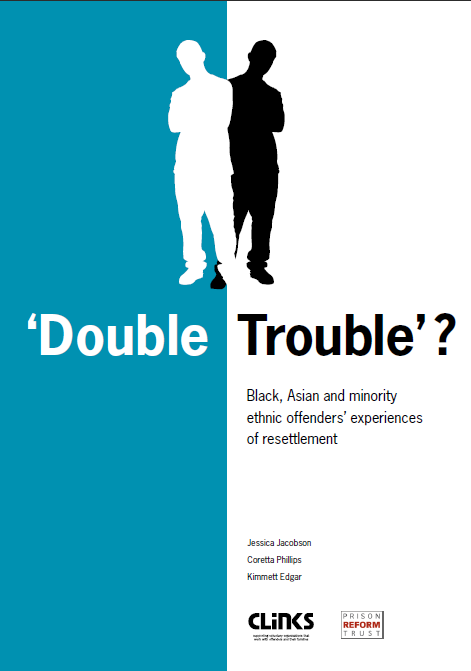Dramatic racial disparity and the persistent struggle of Voluntary and Community Sector (VCS) organisations working to support Black, Asian and Minority Ethnic (BAME) communities in their local areas, have been emphasised by Clinks Members in all of our policy responses. The message is clear: despite the over-representation of BAME individuals at every stage of the Criminal Justice System, there is no coordinated strategy to reverse the trends and BAME-led VCS organisations report disproportionate disadvantage and disengagement from commissioning processes.
The seismic shift in the way that criminal justice services will be commissioned under the reforms outlined by the Transforming Rehabilitation strategy present the Sector with a glimmer of opportunity to craft a more responsive approach. However, while proposals to extend resettlement services and through-the-gate mentoring and to join up relevant local services play well, the Transforming Rehabilitation document is largely silent on the disproportionate presence and reported experiences of BAME service users.
VCS organisations that deliver services to BAME communities and other groups report very limited resources for debating solutions or articulating a concerted strategy. Clinks and partners have been working hard to ensure their voices will be heard in the Transforming Rehabilitation landscape and to provide support and resources to the BAME VCS.
Improving outcomes for BAME young men

In March 2013, Clinks and BTEG convened a joint roundtable hosted by Baroness Young of Hornsey at the House of Lords. The discussion focused upon improving outcomes for young BAME men between the ages of 18 and 25. The fall in the number of young people coming into contact with the youth justice system over the last five years has amplified the disproportionate numbers of young BAME people in the system. Click to download a full event report, which also includes an overview of recent data and research
Delegates at the roundtable emphasised that many of the struggles currently faced by VCS organisations working with those at risk of offending in their communities are particularly acute for BAME-led organisations. The roundtable generated a number of recommendations for improving outcomes for BAME young men, and for the BAME sector more widely. For example, it includes a call to develop a more sophisticated response to how poverty, socioeconomic disadvantage and discrimination intertwine. The persistent pattern of direct and indirect racism in the CJS requires sustained attention and key to that would be a concept of ‘evidence’ for work done in the VCS that acknowledges the perspectives of BAME service users.
Resettlement services for BAME service users:

Research commissioned by Clinks in 2010, Double Trouble, demonstrated the need to make sure that through-the-gate resettlement services are relevant and accessible to BAME service users. The researchers found that, in addition to practical solutions, many prisoners from minority ethnic backgrounds are forced to negotiate an ‘ethnic dimension’ to their engagement with services.
Clinks are now working, with funding from NOMS, to support VCS organisations in the provision of resettlement services to BAME offenders. As well as building on Clinks previous reports and work around race and ethnicity, this project will begin to build on some of the recommendations from the recent roundtable, for example:
- The scope for commissioning specialist services
- Imaginative use of small grants to procure services for BAME offenders
- Developing service user involvement in developing services for BAME offenders
Clinks will work with a network of organisations providing resettlement services to BAME offenders, provide an online portal through which their services can be found, and support organisations to develop and share their practice.
Getting started with crime and ethnicity data:
We have produced an easy-to-use toolkit to give you access to local statistics and information on crime and reoffending. Statistics around the percentage of persons arrested by self-defined ethnicity are viewable by police force area. The toolkit is available to download here - use the tabs at the bottom of the document to find the ethnicity section.
The difficult part - how?
These projects are still at a very early stage but Clinks is seeking the views of our Members and others to help us develop our thinking at this critical time. Here are some questions that we are currently grappling with:
- How can we ensure BAME service users get equal access and benefit from current proposals?
- How can we create opportunities for BAME community groups in the reconfigured services in the Transforming Rehabilitation landscape?
- How can we enable BAME organisations and service users to contribute to the debate and decisions regarding if and when it is appropriate to provide specialist provision for BAME offenders?
We would welcome any thoughts or examples of research and best practice that you have! Post comments below to join the conversation.
What's new
Blogs
Homelessness Strategy Blog
Publications
The Young Review - 10 Years On
Latest on X
The role is for a leader from an organisation focused on racially minoritised people, with expertise in service delivery, policy, advocacy, or related areas in criminal justice. Racial disparities are present at every CJS stage. This role ensures these voices are central in shaping policy to help address and eradicate them. Apply by Mon 18 Nov, 10am. More info: https://www.clinks.org/voluntary-community-sector/vacancies/15566 #CriminalJustice #RR3 #RacialEquity

